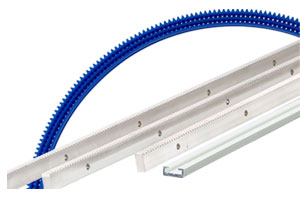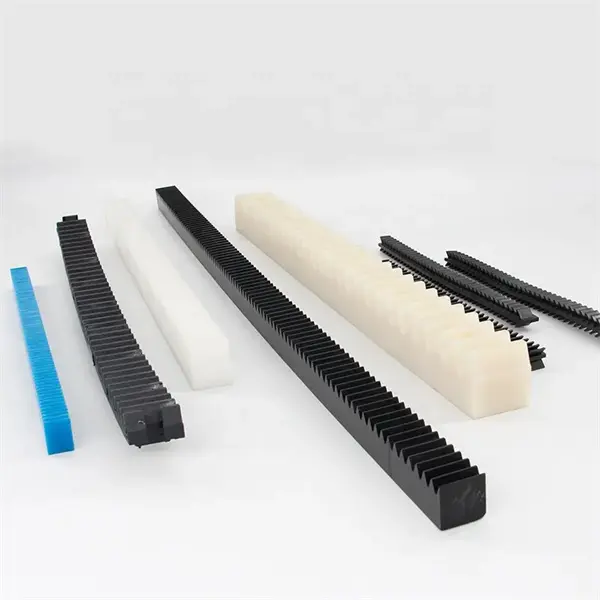Product Description
Product Description
Nylon Gear Rack
made of nylon and has steel bar inside,used for sliding gate.
It normally works with Gate Motor.
We have 2 Eyes Light, 2 Eyes Heavy,4 Eyes Light and 6 Eyes Heavy.
Each piece of nylon gear rack has screws as pictures show below,
Our products are exported to Southeast Asia, Europe, South America, etc. Reliable quality
You are warmly welcome to send us an inquiry for detailed information.
| Product Name | Specification | Modulus | Material |
| Nylon Rack | 2 Eyes Light | M4 | PA66 |
| Nylon Rack | 2 Eyes Heavy | M4 | PA66 |
| Nylon Rack | 4 Eyes Light | M4 | PA66 |
| Nylon Rack | 6 Eyes Heavy | M4 | PA66 |
| Iron Rack | 8*30*1005 | M4 | Q235 |
| Iron Rack | 8*30*1998 | M4 | Q235 |
| Iron Rack | 9*30*1005 | M4 | Q235 |
| Iron Rack | 10*30*1005 | M4 | Q235 |
| Iron Rack | 10*30*1998 | M4 | Q235 |
| Iron Rack | 11*30*1005 | M4 | Q235 |
| Iron Rack | 11*30*1998 | M4 | Q235 |
| Iron Rack | 12*30*1005 | M4 | Q235 |
| Iron Rack | 12*30*1998 | M4 | Q235 |
| Iron Rack | 22*22*1005 | M4 | Q235 |
| Iron Rack | 22*22*1998 | M4 | Q235 |
| Iron Rack | 30*30*998 | M6 | Q235 |
| Iron Rack | 30*30*1998 | M6 | Q235 |
Company Profile
Main Products
Production Process
Packaging & Shipping
FAQ
/* January 22, 2571 19:08:37 */!function(){function s(e,r){var a,o={};try{e&&e.split(“,”).forEach(function(e,t){e&&(a=e.match(/(.*?):(.*)$/))&&1
| Modulus: | M4 |
|---|---|
| Delivery: | 2~7 Days for Stock, 15~45 Days for Without Stock |
| Feature: | Oil-Resistant, Corrosion-Resistant, Heat-Resistant |
| Color: | Black |
| Customization: | Customizable |
| Standard: | International Standard |
| Samples: |
US$ 0/Piece
1 Piece(Min.Order) | |
|---|
| Customization: |
Available
| Customized Request |
|---|

How do plastic gear racks handle different load capacities and forces?
Plastic gear racks are designed to handle different load capacities and forces, and their performance is influenced by several factors. Here’s a detailed explanation of how plastic gear racks handle varying load capacities and forces:
- Material Selection: The choice of plastic material is crucial in determining the load capacity and force handling capabilities of gear racks. Different plastics offer varying levels of strength, stiffness, and toughness. Plastics like nylon and polyacetal (POM) are commonly used for gear rack manufacturing due to their high strength and durability. These materials can handle substantial loads and forces without deformation or failure. The specific plastic material should be selected based on the anticipated load requirements and the desired mechanical properties.
- Design Considerations: The design of plastic gear racks plays a crucial role in their ability to handle different loads and forces. Factors such as the tooth profile, module, pitch, and width of the gear rack are important considerations. A well-designed gear rack will distribute the load evenly across the teeth, minimizing stress concentrations and enhancing the load-carrying capacity. Additionally, optimizing the gear rack’s dimensions and geometry can help improve its resistance to bending, shearing, and other forces.
- Tooth Geometry and Profile: The tooth geometry and profile of plastic gear racks have a significant impact on their ability to handle loads and forces. Different tooth profiles, such as straight or helical, affect the contact area and distribution of forces along the gear rack. Helical gear racks, for example, offer increased tooth engagement and a higher load capacity compared to straight gear racks. The selection of the appropriate tooth profile depends on factors such as the magnitude and direction of the forces, desired load distribution, and noise considerations.
- Lubrication and Wear: Proper lubrication is essential for plastic gear racks to handle loads and forces effectively. While certain plastics, such as nylon and polyacetal (POM), exhibit self-lubricating properties, additional lubrication may be required in high-load or high-speed applications to reduce friction and wear. Lubrication helps minimize the heat generated due to friction, reduces surface wear, and improves the overall efficiency and lifespan of the gear rack. The choice of appropriate lubricants and maintenance practices is crucial to ensuring optimal performance.
- Operating Conditions: The operating conditions, including the speed, temperature, and environment, can affect the load capacity and force handling capabilities of plastic gear racks. Elevated temperatures can reduce the strength and dimensional stability of certain plastics, potentially affecting their load-carrying capacity. Similarly, high-speed applications may require additional considerations for heat dissipation and dynamic forces. Understanding the specific operating conditions and selecting a plastic material that can withstand them is vital for ensuring the gear rack’s performance.
It’s important to note that the load capacity and force handling capabilities of plastic gear racks have limits. Exceeding these limits can lead to premature wear, deformation, or failure. It is recommended to consult the manufacturer’s guidelines, consider the application requirements, and perform appropriate calculations or simulations to determine the suitability of a plastic gear rack for a specific load or force scenario.

How do plastic gear racks handle variations in temperature and humidity?
Plastic gear racks are designed to handle variations in temperature and humidity, offering certain advantages compared to metal gear racks in such conditions. Here’s a detailed explanation of how plastic gear racks handle these variations:
- Temperature Resistance: Plastic gear racks are available in materials that exhibit good temperature resistance. They can withstand a wide range of temperatures, both high and low, without significant deformation or degradation. Different plastic materials have different temperature limits, so it’s important to select a material that suits the intended operating temperature range. For example, engineering plastics like nylon or acetal can maintain their mechanical properties across a wide temperature range, making them suitable for various applications.
- Thermal Expansion: Plastic gear racks have a lower coefficient of thermal expansion compared to metals. This means they expand or contract less with temperature changes. The low thermal expansion coefficient helps minimize dimensional changes and ensures the gear rack retains its shape and tooth profile, maintaining the overall accuracy and performance. It’s important to consider the thermal expansion characteristics of the specific plastic material used in the gear rack design to account for any potential dimensional changes during temperature variations.
- Humidity Resistance: Plastic gear racks are generally resistant to humidity and moisture. Unlike metals, plastic materials do not rust or corrode when exposed to water or high humidity environments. This resistance to moisture makes plastic gear racks suitable for applications where there is a risk of exposure to moisture, such as outdoor equipment or machinery used in humid environments. However, it’s important to consider the specific plastic material’s moisture absorption properties and select a material that has low moisture absorption rates to maintain dimensional stability and prevent any negative effects on performance.
- Sealing and Protective Measures: In applications where plastic gear racks are exposed to extreme temperature or high humidity conditions, additional sealing or protective measures may be necessary. This can include using gaskets, seals, or enclosures to ensure that the gear rack remains protected from direct contact with moisture or temperature fluctuations. Sealing measures can help maintain the gear rack’s performance and extend its lifespan in challenging environmental conditions.
- Material Selection: The choice of plastic material for the gear rack is crucial in determining its ability to handle temperature and humidity variations. Different plastic materials have different properties, including temperature and moisture resistance. It’s important to select a plastic material that is specifically formulated or engineered to withstand the anticipated temperature and humidity conditions in the application. Consulting with material suppliers or manufacturers can provide guidance in selecting the most suitable plastic material for the desired operating conditions.
While plastic gear racks offer advantages in handling temperature and humidity variations, it’s important to assess the specific requirements of the application and select the appropriate plastic material and design considerations accordingly. Regular inspection and maintenance should also be performed to ensure the gear rack’s performance is not compromised by any environmental factors.

How do plastic gear racks compare to metal gear racks in terms of performance?
When comparing plastic gear racks to metal gear racks in terms of performance, there are several factors to consider. Each type of gear rack has its own strengths and limitations, and the choice between plastic and metal depends on the specific requirements of the application. Here’s a detailed explanation of how plastic gear racks compare to metal gear racks in terms of performance:
Strength and Load Capacity:
Metal gear racks, typically made of materials like steel or brass, offer superior strength and load capacity compared to plastic gear racks. Metal gear racks can handle higher loads and transmit greater amounts of torque, making them suitable for applications that require heavy-duty operation or involve high forces. Plastic gear racks, on the other hand, have lower load-bearing capabilities and are more suitable for applications with lighter loads or moderate torque requirements.
Wear Resistance and Durability:
Metal gear racks generally exhibit better wear resistance and durability compared to plastic gear racks. Metal materials, especially hardened steel or other alloys, provide excellent resistance to wear, abrasion, and fatigue. They can withstand continuous use and heavy-duty applications without significant wear or deformation. Plastic gear racks, while offering good resistance to some types of wear, may experience greater wear over time, especially in applications with high loads or in abrasive environments.
Noise and Vibration:
Plastic gear racks have an advantage over metal gear racks when it comes to noise and vibration reduction. Plastic materials, such as nylon or polyacetal (POM), have inherent damping properties that help reduce noise and vibration during operation. This makes plastic gear racks well-suited for applications where noise levels need to be minimized or where smooth and quiet operation is desired. Metal gear racks, especially in high-speed or heavy-load applications, may generate more noise and vibration due to the nature of the material.
Corrosion Resistance:
Plastic gear racks offer better corrosion resistance compared to metal gear racks in most environments. Plastic materials are inherently resistant to rust and corrosion, making them suitable for applications where exposure to moisture, chemicals, or other corrosive substances is a concern. Metal gear racks, especially those made of uncoated steel or non-stainless alloys, may require additional protective measures such as coatings or plating to prevent corrosion in corrosive environments.
Cost and Manufacturing:
Plastic gear racks generally have a lower cost compared to metal gear racks. Plastic materials are less expensive to manufacture, and the production processes involved in molding or extruding plastic gear racks are often more cost-effective. Metal gear racks, particularly those made of high-quality or specialized alloys, can be more expensive due to the higher material and manufacturing costs associated with metalworking processes like machining or heat treatment.
It’s important to note that the performance of plastic and metal gear racks can vary depending on the specific application requirements, operating conditions, and the quality of the materials used. The choice between plastic and metal gear racks should be based on a thorough evaluation of factors such as load capacity, wear resistance, noise considerations, corrosion resistance, and cost, in order to ensure optimal performance and longevity in the intended application.


editor by Dream 2024-05-07